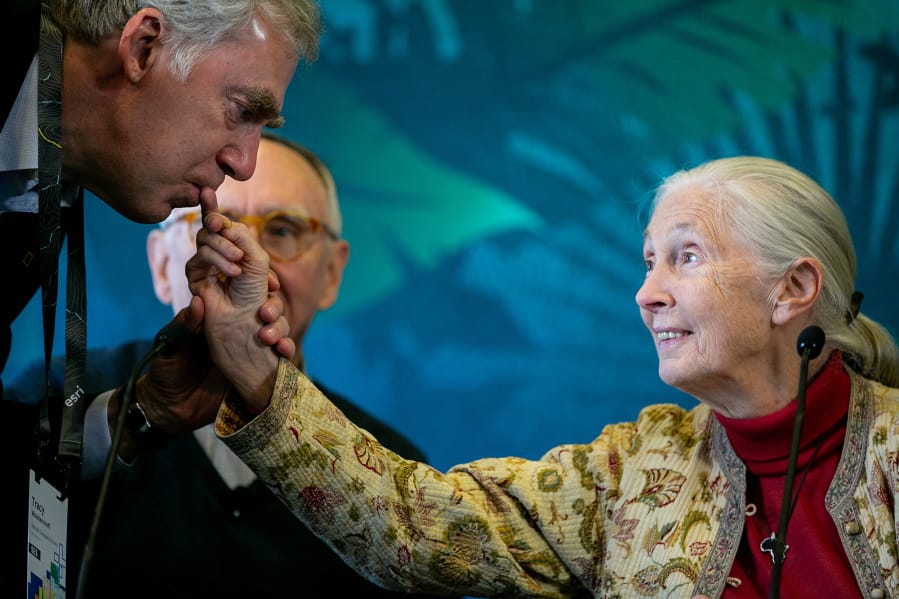SAN DIEGO — In groundbreaking research beginning nearly 60 years ago, Jane Goodall has devoted her life to understanding our closest relatives, chimpanzees.
Goodall, 85, lived among chimps in Tanzania’s Gombe Stream National Park, gathering observations that reached the public in a series of popular books. She was first scientist to describe chimpanzees as individuals, giving them memorable names such as Flo, Fifi and Flint. She also depicted how chimps live in societies, in peace, conflict and even war.
Now the English primatologist has enlisted a provider of 21st-century mapping science to understand and protect nature, and help their human neighbors thrive alongside wildlife without conflict.
Goodall and Geographic Information System, or GIS, provider Esri announced the partnership July 8 at Esri’s 2019 user meeting in San Diego.
The Redlands-based company will provide the Jane Goodall Institute GIS software tools to document natural and human resources, including wildlife reserves, towns, and flood control areas. The institute, fellow scientists and local volunteers will collect the information and with Esri’s help, use that knowledge to refine their conservation efforts.
Esri’s software puts data into visual formats that people can more easily interpret. Patterns that might now be obvious from a list of numbers leap out from a map. City, state and federal governments, companies and nonprofits buy Esri’s software for that purpose.
For example, in the Northern Ireland town of Lurgan, students could map areas where people feel unsafe, guiding efforts to integrate Protestants and Catholics — an actual project discussed at the meeting.
Speaking July 8 to the meeting, Goodall said a major goal of the institute is to prevent or end conflict between wildlife and the welfare of people living nearby.
For the safety of chimpanzees such as those she studies in Tanzania, willing cooperation with villages is essential, and ESRI is already helping, Goodall said. The scientists get help from volunteers under an institute program called Tacare.
“We began with 12 villages and we’re now up to 104,” Goodall said. “Most of the chimpanzees in Tanzania are not protected. They’re not in any of the parks or reserves. They’re just in village or forest reserves where they’re not protected at all.”
Volunteers in those villages are working with the institute because they understand that protecting the environment helps people, too, Goodall said.
“They’re not just doing it for the chimps.”
Goodall said getting a better understanding of chimpanzees also helps humans get a better sense of where we fit into nature.
“The chimps are so like us biologically, as well as behaviorally, that science was forced to start thinking differently, that we’re part of the animal kingdom and not separated from it.”
On July 9, Goodall and Esri President Jack Dangermond urged the public to get involved in conservation, at whatever level they can.
“I don’t care whether it’s gardening or working in a factory,” he said. “Everyone can do something.”
And it’s important not to despair, Goodall said. If given help, nature can recover, and projects around the world show that this is possible.
“The press tends to pick on the doom and the gloom because it’s newsworthy,” Goodall said. “But I want the press to equally highlight all those amazing people and incredible projects around the world, that are making a difference, that are restoring destroyed landscapes, that are saving species on the brink of extinction.”
The San Diego Zoo’s decadeslong and successful effort to bring the California condor back from the brink of extinction represents one of those success stories, Goodall said.
People who don’t know of such successes might just give up, she said.
“If people lose hope, they become apathetic,” Goodall said. “Because if there is no hope … why bother?”




